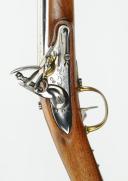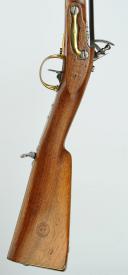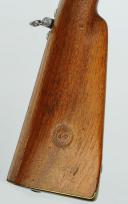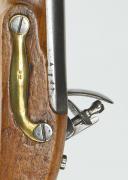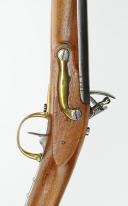
MOUSQUETON DE GENDARMERIE, MODÈLE AN IX, RESTAURATION, SECONDE FABRICATION.
Sold out
GENDARMERIE MUSKET, MODEL YEAR IX, RESTAURATION, SECOND MANUFACTURE.
Barrel with five short-flat sides at the breech, stamped "A 342", plain butt without inscription, length 0.758 m. Caliber 17 mm.
Walnut stock with a short forearm exposing the barrel, serial number "74" "PLD" (property of the state), with a stamp of acceptance from the Mutzig Arms Manufacture, likely for a repair or maintenance within the factory.
Brass muzzle cap with a beak retaining the iron sling swivel. Trigger guard, side plate, and butt plate made of brass.
Flintlock marked "Manufacture Royale de St Etienne" Year IX. Second Production from 1813-1815.
Iron ramrod with a conical head.
Total length of the weapon: 1.045 m.
In perfect state of conservation.
France.
Restoration.
NOTE:
END OF A LEGEND "PDL" THE MARKING ON NATIONAL GUARD WEAPONS
Extensive research has failed to uncover any evidence that could attest to the reality of this motto "Pour le droit" (For the right). So, what is it all about? What is the National Guard? The National Guard was created during the Revolution. It is a militia tasked with maintaining order and upholding the law in troubled times. It consists of all citizens aged 20 to 60. They are listed and classified for service, either as reserve guards or active guards. Initially, the National Guards were mostly bourgeois as they were asked to equip themselves at their own expense, and to be in the cavalry, one needed to own a horse. For the bourgeoisie, this role was a way to maintain a form of power, to stand out from the population of other citizens. The National Guards were distributed across all municipalities. They acted as a "Police force" under the orders of a commander, the mayor, and the prefect. Under the Empire, the National Guard sometimes served as a reserve army and was mobilized during Napoleon's wars. After the dissolution of the National Guards by Charles X in 1827, it was recreated by Louis Philippe in 1830. There would be a company in each municipality, comprising infantry, artillery, cavalry, and also firefighters. The National Guard was reactivated to quell disturbances and maintain calm across France after the July Revolution.
Marking of weapons with 'PDL' in 1831
By the end of 1830, the minister aimed to bring order to the National Guards. He sought to organize the troops and ordered the collection and registration of weapons distributed earlier during the July Revolution. A document from the Lyon city archives dated August 10, 1830, attests to this.
In January 1831, a circular from the minister decided to mark the weapons distributed by the Ministry of War and thus belonging to the state. These were to be stamped with a seal "PDL" denoting "Property Of the State," as indicated in a document dated January 20, 1831, from the prefecture in the Lyon archives.
This mark would be made using a punch that circulated from village to village in each canton. The stamping would take place in the presence of the National Guards assembled in arms by the mayors and commanders. The punch would remain the property of the canton's chief town, allowing for ongoing marking in the future. A report would be drawn up, signed by the mayor, and sent to the prefecture.
It is noted that weapons owned by municipalities, purchased at their own expense, or by the National Guards were not subject to this marking measure.
The equipment of the National Guards was quite diverse. It included rifles, swords, cartridge boxes, and other military-type equipment and uniforms often of private manufacture, differing somewhat from standard models. These were acquired by the National Guards themselves as well as by the municipalities. Additionally, there were standard weapons provided to the municipalities by the Ministry of War.
Only this latter category of state-owned equipment was to be marked by the ministry to demonstrate ownership and prevent the dispersal of weapons. An excerpt from the January 1831 circular reproduces the printed notice accompanying the punch designated for the municipalities. The same circular mentions the creation, with the approval of the Minister of the Interior, of an arms manual intended for the National Guards.
In 1848, following the February Revolution and the advent of the Second Republic, a decree reactivated the National Guard in March. The front page of "Le Courrier de la Drome et de l'Ardèche" from October 29, 1848, No. 224, shows that the same measures as in 1831 (a law still in force) were taken with the census of National Guards and their weapons. The marking "PDL" on state-owned weapons is reiterated. It is also noted that the conversion to percussion of National Guard weapons by private gunsmiths is prohibited to avoid proliferation of available calibers.
The 'PLD' Mark
The mark on the wood created by striking a blackened metal imprint presents these three letters PDL. For a long time, these have been interpreted as a motto "Pour Le Droit," which seems to have no basis. These documents show that it is simply a reminder of the "Property Of the State." The rooster at the top recalls a national symbol that was emphasized by Louis Philippe upon his accession to power in 1831. This stamp is found on the stocks of pistols and the standard rifles used by the National Guard. These were mostly pistols of the 1816 or 1822 troop models and frequently the rifles of the 1777 corrected An IX model. The Ministry of War distributed weapons with an outdated system to the National Guards, reserving the more recent 1822 models for the military. Subsequently, there were the models 1822 T and Tbis.
Evolution of the PDL Mark
Furthermore, consulting military archive records has revealed other developments in this state identification mark.
On White Weapons with PDL Too
Examination of swords or bayonets sometimes also reveals this stamped mention.
Barrel with five short-flat sides at the breech, stamped "A 342", plain butt without inscription, length 0.758 m. Caliber 17 mm.
Walnut stock with a short forearm exposing the barrel, serial number "74" "PLD" (property of the state), with a stamp of acceptance from the Mutzig Arms Manufacture, likely for a repair or maintenance within the factory.
Brass muzzle cap with a beak retaining the iron sling swivel. Trigger guard, side plate, and butt plate made of brass.
Flintlock marked "Manufacture Royale de St Etienne" Year IX. Second Production from 1813-1815.
Iron ramrod with a conical head.
Total length of the weapon: 1.045 m.
In perfect state of conservation.
France.
Restoration.
NOTE:
END OF A LEGEND "PDL" THE MARKING ON NATIONAL GUARD WEAPONS
Extensive research has failed to uncover any evidence that could attest to the reality of this motto "Pour le droit" (For the right). So, what is it all about? What is the National Guard? The National Guard was created during the Revolution. It is a militia tasked with maintaining order and upholding the law in troubled times. It consists of all citizens aged 20 to 60. They are listed and classified for service, either as reserve guards or active guards. Initially, the National Guards were mostly bourgeois as they were asked to equip themselves at their own expense, and to be in the cavalry, one needed to own a horse. For the bourgeoisie, this role was a way to maintain a form of power, to stand out from the population of other citizens. The National Guards were distributed across all municipalities. They acted as a "Police force" under the orders of a commander, the mayor, and the prefect. Under the Empire, the National Guard sometimes served as a reserve army and was mobilized during Napoleon's wars. After the dissolution of the National Guards by Charles X in 1827, it was recreated by Louis Philippe in 1830. There would be a company in each municipality, comprising infantry, artillery, cavalry, and also firefighters. The National Guard was reactivated to quell disturbances and maintain calm across France after the July Revolution.
Marking of weapons with 'PDL' in 1831
By the end of 1830, the minister aimed to bring order to the National Guards. He sought to organize the troops and ordered the collection and registration of weapons distributed earlier during the July Revolution. A document from the Lyon city archives dated August 10, 1830, attests to this.
In January 1831, a circular from the minister decided to mark the weapons distributed by the Ministry of War and thus belonging to the state. These were to be stamped with a seal "PDL" denoting "Property Of the State," as indicated in a document dated January 20, 1831, from the prefecture in the Lyon archives.
This mark would be made using a punch that circulated from village to village in each canton. The stamping would take place in the presence of the National Guards assembled in arms by the mayors and commanders. The punch would remain the property of the canton's chief town, allowing for ongoing marking in the future. A report would be drawn up, signed by the mayor, and sent to the prefecture.
It is noted that weapons owned by municipalities, purchased at their own expense, or by the National Guards were not subject to this marking measure.
The equipment of the National Guards was quite diverse. It included rifles, swords, cartridge boxes, and other military-type equipment and uniforms often of private manufacture, differing somewhat from standard models. These were acquired by the National Guards themselves as well as by the municipalities. Additionally, there were standard weapons provided to the municipalities by the Ministry of War.
Only this latter category of state-owned equipment was to be marked by the ministry to demonstrate ownership and prevent the dispersal of weapons. An excerpt from the January 1831 circular reproduces the printed notice accompanying the punch designated for the municipalities. The same circular mentions the creation, with the approval of the Minister of the Interior, of an arms manual intended for the National Guards.
In 1848, following the February Revolution and the advent of the Second Republic, a decree reactivated the National Guard in March. The front page of "Le Courrier de la Drome et de l'Ardèche" from October 29, 1848, No. 224, shows that the same measures as in 1831 (a law still in force) were taken with the census of National Guards and their weapons. The marking "PDL" on state-owned weapons is reiterated. It is also noted that the conversion to percussion of National Guard weapons by private gunsmiths is prohibited to avoid proliferation of available calibers.
The 'PLD' Mark
The mark on the wood created by striking a blackened metal imprint presents these three letters PDL. For a long time, these have been interpreted as a motto "Pour Le Droit," which seems to have no basis. These documents show that it is simply a reminder of the "Property Of the State." The rooster at the top recalls a national symbol that was emphasized by Louis Philippe upon his accession to power in 1831. This stamp is found on the stocks of pistols and the standard rifles used by the National Guard. These were mostly pistols of the 1816 or 1822 troop models and frequently the rifles of the 1777 corrected An IX model. The Ministry of War distributed weapons with an outdated system to the National Guards, reserving the more recent 1822 models for the military. Subsequently, there were the models 1822 T and Tbis.
Evolution of the PDL Mark
Furthermore, consulting military archive records has revealed other developments in this state identification mark.
On White Weapons with PDL Too
Examination of swords or bayonets sometimes also reveals this stamped mention.
Reference :
6474
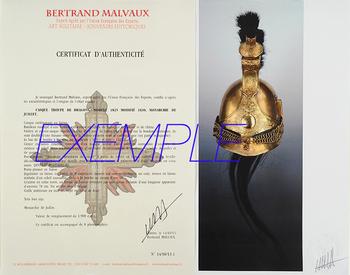
Next update Friday, april 4th at 1:30 PM
FOR ALL PURCHASES, PAYMENT IN MULTIPLE CHECKS POSSIBLE
bertrand.malvaux@wanadoo.fr 06 07 75 74 63
An authenticity certificate of the item including the description published on the site, the period, the sale price, accompanied by one or more color photographs is automatically provided for any item priced over 130 euros. Below this price, each certificate is charged 5 euros.
Only items sold by me are subject to an authenticity certificate, I do not provide any expert reports for items sold by third parties (colleagues or collectors).
